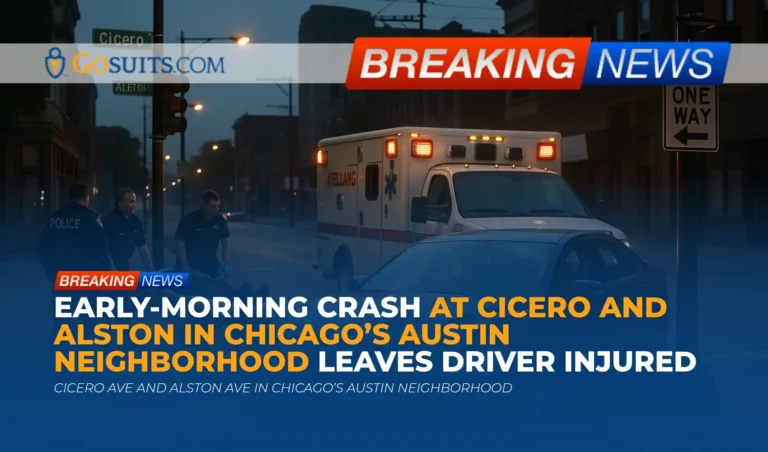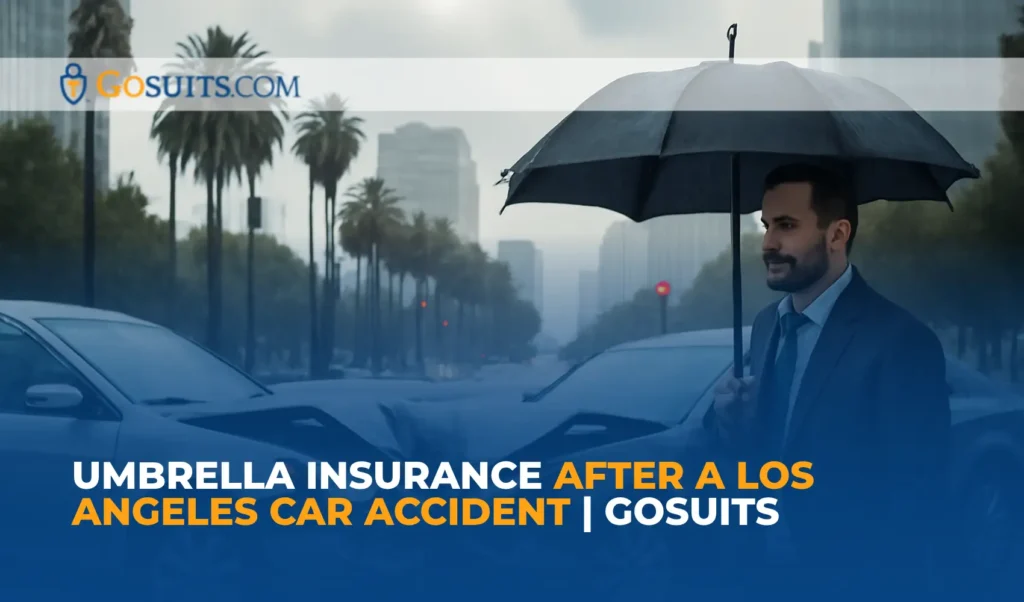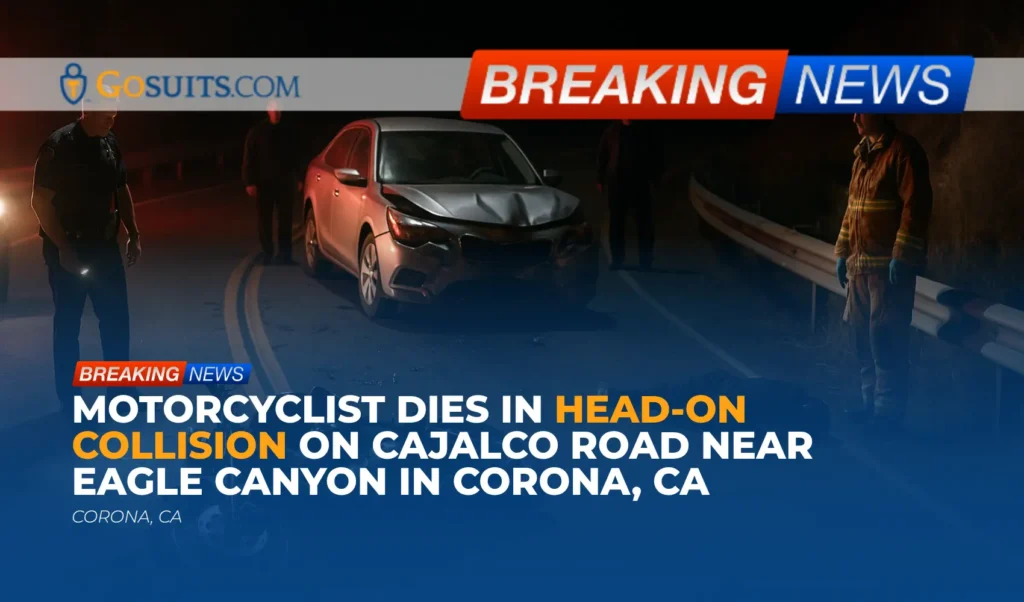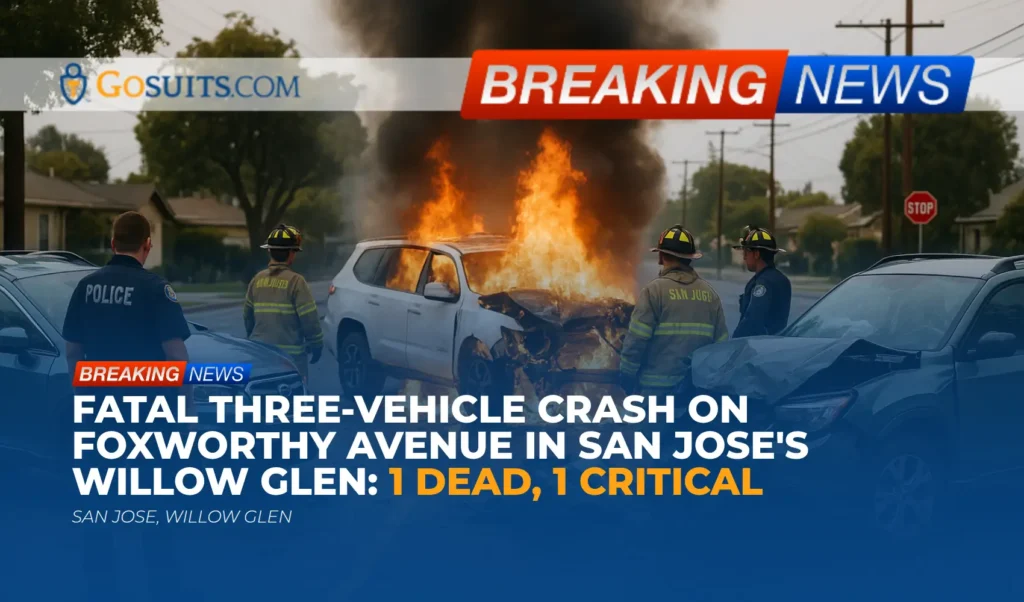- What is known about the early-morning crash at Cicero Ave and Alston Ave in Chicago’s Austin neighborhood
- Immediate safety and medical response
- Why urban intersections and early-morning hours raise risk
- Practical steps after a serious vehicle crash in Illinois
- How Illinois law may apply to a single-vehicle crash
- Insurance considerations in Illinois
- Where to obtain official records and help in Chicago and Cook County
- Evidence that can help clarify what happened
- Rights and timelines that affect civil claims in Illinois
- Approaching insurance communications carefully
- Action steps that matter now
- Commentary from Gosuits Chicago, Illinois Personal Injury Attorney
What is known about the early-morning crash at Cicero Ave and Alston Ave in Chicago’s Austin neighborhood
Early Sunday morning on October 27, 2025, a traffic collision with injuries was reported at the intersection of Cicero Avenue and Alston Avenue in the Austin neighborhood on Chicago’s West Side. Dispatch information indicates the incident occurred around 2:08 a.m. and involved a black Ford. Responding Chicago Police personnel and medical responders found a male driver slumped over the steering wheel. Ambulance 46 arrived to provide emergency care. At the time of reporting, officials had not released details about the sequence of events leading up to the crash, nor the driver’s condition following treatment. The intersection was secured while first responders rendered aid and conducted preliminary assessments. The incident remains under investigation.
It is understandable for neighbors, families, and passersby to seek clarity after a sudden collision in a residential corridor. When a driver is found unresponsive, possible explanations can include trauma-related effects from the impact, a pre-existing medical event, or other factors that require careful medical evaluation and thorough investigation. Until authorities release additional information, it is important to avoid assumptions and allow the formal process to proceed.
Immediate safety and medical response
First responders’ priorities in a scenario like this include assessing consciousness and airway, stabilizing the spine as indicated, managing bleeding, and quickly transporting if needed. In Chicago, emergency medical services are provided by the Chicago Fire Department, which coordinates on-scene triage and hospital transport. Clearing and securing the intersection helps prevent secondary collisions and preserves the scene for investigators.
People who witness similar incidents can help by calling 911, providing precise location details, and staying a safe distance away unless directed by responders. If safe and appropriate, noting visible hazards or vehicle positions may be useful for investigators later, but safety and medical care take precedence over documentation in the moment.
Why urban intersections and early-morning hours raise risk
Urban intersections concentrate cross-traffic, turning movements, pedestrians, and cyclists. Even when traffic volume is lower overnight, risk does not disappear. At night and in the early morning hours, visibility is reduced, and drivers can be fatigued. Environmental factors such as poorly lit approaches, confusing lane markings, or obstructed sight lines can compound the risk of serious injury.
Transportation safety agencies note that nighttime crashes are more likely to result in severe outcomes than daytime crashes. National analyses also show that intersections are frequent locations for multi-factor events where driver behavior, roadway design, and environmental conditions intersect. For context and further reading, see resources from the National Highway Traffic Safety Administration and the Illinois Department of Transportation for crash trends and safety insights:
In neighborhoods like Austin, where residential streets meet major corridors, balancing mobility and safety depends on roadway design features, signal timing, signage, nighttime visibility, and driver attention. Careful post-crash analysis helps public agencies identify whether infrastructure or operations changes could reduce future harm.
Practical steps after a serious vehicle crash in Illinois
After any serious collision, health and safety come first. Once immediate medical needs are addressed, several steps can help protect rights and clarify what happened. The following are general considerations for people affected by a motor vehicle crash in Illinois:
- Prioritize medical evaluation. Some injuries do not show symptoms right away. A timely exam creates a medical record consistent with the incident and supports appropriate treatment planning.
- Document what you safely can. Photos of the vehicles, the intersection, skid marks, debris, and lighting conditions can be helpful. If there are witnesses, their contact information may be important later.
- Preserve items and records. Keep medical discharge paperwork, imaging orders, medication lists, and bills. Save towing receipts and communications with insurers. If a vehicle is totaled, request in writing that it be preserved until you can photograph it or have it inspected.
- Consider legal consultation early. A brief consultation can help identify coverage options, protect potential claims, and avoid pitfalls. It also allows for sending timely preservation requests for evidence, including vehicle data.
- Mind reporting obligations. Police officers typically complete an Illinois Traffic Crash Report when a crash involves injury, death, or significant property damage. State law addresses officer reporting of crashes to the transportation department. See 625 ILCS 5/11-408.
How Illinois law may apply to a single-vehicle crash
Although this crash currently appears to involve a single vehicle, liability questions can still be complex. Several civil-law concepts may be relevant depending on the facts investigators uncover:
- Negligence and comparative fault. Illinois follows a modified comparative negligence rule. An injured person’s compensation may be reduced by any percentage of fault assigned to them, and recovery is barred if they are more than 50 percent at fault. See 735 ILCS 5/2-1116.
- Third-party responsibility. Even in single-vehicle crashes, third parties can be responsible. Examples include a vehicle defect, negligent repair or maintenance, a roadway hazard, or the actions of another driver who left the scene. Investigators and reconstruction experts often explore these possibilities.
- Roadway condition and public entities. Public bodies have a duty to maintain property in a reasonably safe condition, subject to statutory immunities and defenses. Claims involving roadway design or maintenance are fact-intensive and time-sensitive. See 745 ILCS 10/3-102.
- Alcohol service and dram shop liability. If evidence shows an establishment unlawfully contributed to a patron’s intoxication leading to injury, a civil claim may be available under Illinois’ dram shop provisions. See 235 ILCS 5/6-21. This depends entirely on verified facts, not assumptions.
- Work-related driving. When a crash occurs during the course of employment, workers’ compensation and additional third-party claims may be implicated, depending on circumstances.
- Vehicle event data recorders. Many vehicles store crash-related data such as speed and braking inputs for brief intervals. Timely preservation can help reconstruct events. For background, see NHTSA’s overview of Event Data Recorders.
Each of these concepts requires careful factual development. Early steps to secure the vehicle, preserve data, and obtain official records can make a measurable difference in understanding what occurred.
Insurance considerations in Illinois
Illinois uses a fault-based auto insurance system. Liability insurance is mandatory, and uninsured motorist coverage is required at least at minimum limits. See the Illinois Secretary of State’s overview of auto insurance requirements at ilsos.gov. The Illinois Department of Insurance provides consumer guidance on policy types and claims at idoi.illinois.gov.
Practical coverage issues that frequently arise after serious crashes include:
- Liability coverage. Pays for injuries and damage caused by a policyholder deemed legally responsible, up to policy limits.
- Uninsured/underinsured motorist (UM/UIM). Applies when an at-fault driver has no insurance or insufficient limits. In single-vehicle events, UM can sometimes be implicated where a hit-and-run or unidentified vehicle contributed to the crash, subject to policy terms and proof standards.
- Medical payments coverage (MedPay). Optional coverage that may pay certain medical expenses regardless of fault, up to selected limits.
- Collision and comprehensive. Cover vehicle repairs or replacement, less any deductible, depending on the cause of loss and policy terms.
- Health insurance and liens. Hospitals and certain providers may assert liens against third-party recoveries in Illinois. The Illinois Hospital Lien Act governs procedures and limits. See 770 ILCS 23.
Policies vary widely. Reviewing declarations, endorsements, exclusions, and coordination with health insurance is important. Early, careful navigation helps avoid missteps that could narrow available benefits.
Where to obtain official records and help in Chicago and Cook County
Obtaining accurate records helps clarify facts and supports any insurance or civil claim. In and around the Austin neighborhood, the following agencies are typical sources of official documentation and assistance:
Police crash reports and records
- Chicago Police Department (CPD) crash report. When injury crashes occur, officers generally prepare an Illinois Traffic Crash Report. Police crash reports are used by insurers and are frequently requested in civil claims. CPD records can be requested under the City’s public-records process. See the City of Chicago’s FOIA page at chicago.gov. State law governing officer crash reporting is at 625 ILCS 5/11-408.
- Illinois State Police (ISP) crash reports. If a crash is investigated by ISP rather than CPD, reports can be obtained through the ISP crash report system. See isp.illinois.gov/CrashReports.
Medical and EMS records
- Ambulance and EMS. Chicago Fire Department units provide emergency medical response and transport. Records requests for incident and EMS documentation may be directed to the City through its records request process and applicable health privacy laws. Access general information about the department at chicago.gov and the City’s FOIA process at chicago.gov.
- Hospital records. Treating hospitals can provide medical records with proper authorization. Hospitals may later assert liens under Illinois law; see 770 ILCS 23.

Medical examiner and autopsy information
- Cook County Medical Examiner’s Office. In cases involving fatalities, the Medical Examiner investigates and maintains records related to cause and manner of death. Families can learn about requests at cookcountyil.gov.
Additional City resources
- Emergency and non-emergency services. For emergencies, dial 911. For non-emergency City services or to report infrastructure concerns, Chicago’s 311 system is available; see the City’s main portal at chicago.gov.
- Towed vehicles. If a damaged vehicle was removed from the scene, information about auto pound locations and releases is available via the City’s site. Start at chicago.gov and search “auto pound” for current details.
Motorist reporting obligations
- Officer reports and motorist responsibilities. Illinois law addresses crash reporting by police officers and establishes obligations for motorists in injury and significant damage crashes. See 625 ILCS 5/11-408 for officer reporting provisions. The Illinois Department of Transportation provides safety and crash-reporting resources at idot.illinois.gov.
Evidence that can help clarify what happened
Thorough investigations look beyond initial impressions. For early-morning intersection crashes, some or all of the following may be important:
- Scene documentation. Photographs of vehicle rest positions, exterior and interior damage, airbag deployment, skid marks, debris fields, and roadway markings provide context. Nighttime lighting and signage visibility should be captured if possible.
- Witness statements. Independent witnesses can corroborate critical details like signal phases, speed estimation, or evasive maneuvers. Collect names and contact information when it is safe to do so.
- Vehicle inspections. Mechanical evaluations can rule out or reveal brake, steering, tire, or electronic failures. For later-model vehicles, downloading the Event Data Recorder can show pre-crash inputs and speeds. See NHTSA’s EDR resource for background.
- Medical records. Clinical notes and diagnostic imaging help establish injury causation and timing, including whether an underlying medical emergency preceded or followed the crash.
- Public-entity records. Traffic signal timing plans, maintenance logs, sign work orders, or 311 complaints can shed light on whether infrastructure or maintenance issues contributed. Requests may be made under the Illinois Freedom of Information Act. See 5 ILCS 140.
Because some evidence is transient, preservation letters and timely requests can be vital. For example, some video systems overwrite footage in days or weeks, and totaled vehicles may be salvaged quickly without notice unless a hold is requested.
Rights and timelines that affect civil claims in Illinois
Illinois law imposes deadlines for bringing civil claims. Missing a deadline can extinguish rights regardless of the merits. Key timelines include:
- Personal injury limitations period. In many cases, a claim for bodily injury must be filed within two years of the date of injury. See 735 ILCS 5/13-202.
- Claims against local public entities. Actions against local public bodies (for example, certain roadway condition claims) are generally subject to a one-year limitations period. See 745 ILCS 10/8-101.
Other deadlines may apply depending on the facts, such as notice requirements for certain claims. Because the correct timeline can vary, early attention to deadlines helps prevent inadvertent loss of rights.
Approaching insurance communications carefully
Insurance adjusters are tasked with investigating claims and minimizing their company’s payout exposure within the policy terms. What is said in an early phone call can shape how a claim is handled later. Before initiating recorded statements or signing authorizations that grant broad access to medical history, consider consulting with counsel. A short, no-cost consultation can help clarify rights and obligations and can identify the safest order of steps.
If a claim will be pursued, it is often prudent to gather key documents first: the police crash report, initial medical records, photographs, and information about employment and wage loss if applicable. When a vehicle is a potential source of evidence, avoid consenting to disposal until necessary inspections are complete.
Action steps that matter now
Taking a few timely steps can preserve important rights and evidence. The following actions are generally appropriate after a serious crash in an urban intersection:
- Secure the basics. Obtain prompt medical evaluation and follow discharge instructions. Keep copies of all records and bills.
- Request key documents. Seek the police crash report number and hospital discharge paperwork; note the tow yard location if applicable.
- Preserve the vehicle and data. Ask the tow yard or insurer in writing to hold the vehicle until inspections and photographs can occur. This is especially important for vehicles with Event Data Recorders.
- Identify potential video. Note any nearby cameras on intersections, businesses, or residences. Video often overwrites quickly; preservation requests should be made as soon as possible.
- Be cautious with insurance statements. Consider consulting an attorney before giving recorded statements. Statements can be used later to dispute causation or damages.
- Calendar deadlines. Note the two-year general personal injury period and the one-year period for many claims against local public entities, based on the statutes cited above. Acting within the correct timeframe is critical.
Acting methodically, even in a stressful period, improves the accuracy of the record and supports informed decisions about health, transportation, work, and any civil claim.

Commentary from Gosuits Chicago, Illinois Personal Injury Attorney
Our thoughts are with the driver who was injured at Cicero Avenue and Alston Avenue, and with everyone affected by this early-morning crash in the Austin neighborhood. The information here is intended for general educational purposes to help community members understand how investigations unfold and what steps can protect health and rights after a serious collision.
Based on what is known publicly, several avenues of inquiry make sense: whether roadway conditions or visibility played a role, whether a pre-existing medical event contributed, whether another vehicle’s actions precipitated evasive maneuvers, and whether vehicle systems functioned properly. None of these possibilities can be confirmed without evidence, but they illustrate why preserving the vehicle, obtaining the official crash report, and documenting the scene and medical course are so important.
In our experience, insurance companies and large corporations often move quickly to collect statements, secure their own experts, and frame the narrative of a claim. This can leave injured people at a disadvantage, especially if they are unfamiliar with coverage layers, lien rights, comparative fault, and the specific deadlines that apply in Illinois. Adjusters may request broad medical authorizations or encourage early statements before the full extent of injuries is known, and those materials are sometimes used later to challenge causation or reduce a claim’s value within the policy framework.
A free consultation with a seasoned, skilled injury attorney helps level the playing field. It costs nothing to learn how evidence should be preserved, how to approach communications with insurers, which coverages may apply, and which deadlines matter. An early conversation can also reduce stress by providing a plan for requesting records from CPD and medical providers, holding the vehicle for inspection, and identifying any additional parties who should be placed on notice. While no attorney can promise outcomes, timely guidance can make the process clearer and more manageable for those dealing with the aftermath of a serious crash.
Sources and further reading
General safety, reporting, and legal references used in this article:
- Illinois Department of Transportation — Safety
- National Highway Traffic Safety Administration
- 625 ILCS 5/11-408 — Reports by police officers
- 735 ILCS 5/2-1116 — Comparative negligence
- 735 ILCS 5/13-202 — Personal injury limitations period
- 745 ILCS 10/8-101 — Claims against local public entities
- 745 ILCS 10/3-102 — Public entity duty
- 235 ILCS 5/6-21 — Dram shop liability
- 770 ILCS 23 — Illinois Hospital Lien Act
- Illinois Secretary of State — Auto Insurance Requirements
- Illinois Department of Insurance — Auto Insurance
- City of Chicago — FOIA and Records Requests
- Cook County Medical Examiner
- Chicago Fire Department — EMS and Fire Services
- Illinois State Police — Crash Reports
- NHTSA — Event Data Recorders






